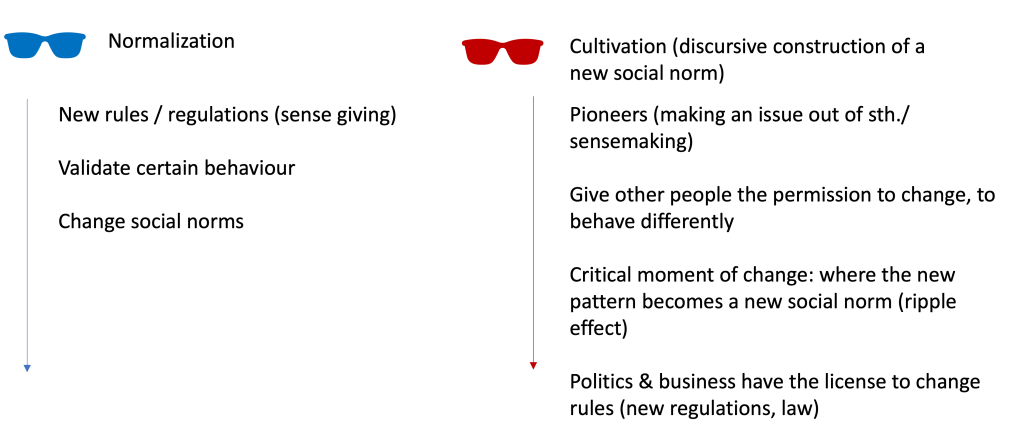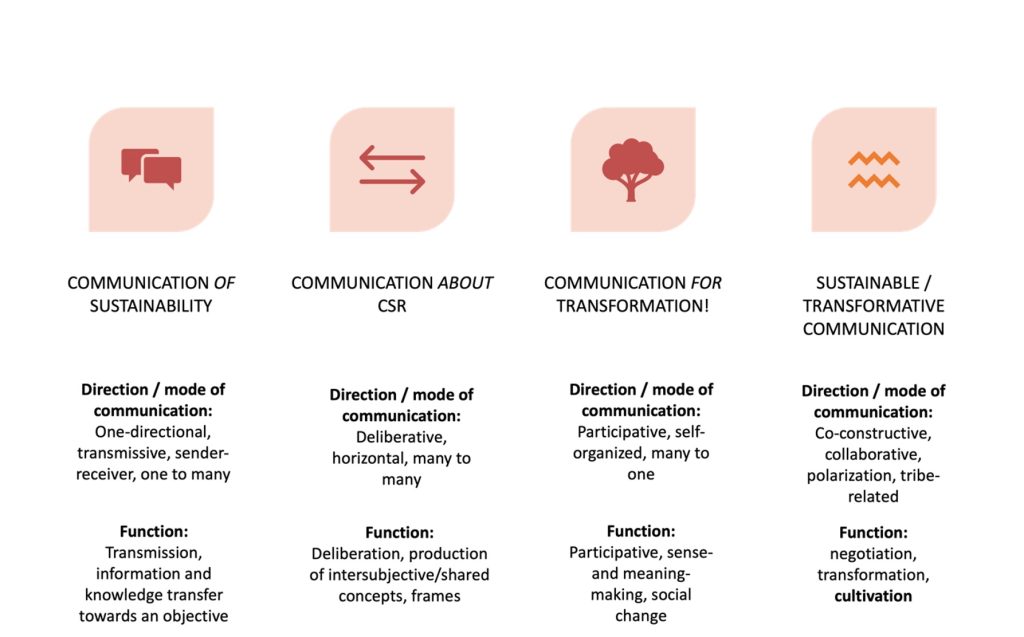Outlook
Franzisca Weder
The lady…
At the beginning of this book on CSR Communication and Cultures of Sustainability, we met a lady; we started communicating, we got her off her bike, listened to her and her thoughts and reflections, and together we started to put communication of and about CSR into question and shared our thoughts on communication for sustainability and transformation.
CSR communication includes thinking about sustainability communicators, sustainability stories and best practices of sustainability communication, CSR related audiences and stakeholders, as well as the potential to cultivate sustainability as universal value in and through (social) media channels, public discourses and conversational spaces. The first part of the book offered a terminological clean up and background knowledge around CSR and Sustainability studies. In these chapters, processes and structures of communication were identified as the missing link to fully grasp socio-ecological transformation processes and explore the key role of organizations in these processes of social change. Therefore, we introduced the main (sociological) paradigms that are used to understand communication, it’s direction, dynamic, function and potential effects. We also explored what aspects of CSR and sustainability communication are already researched and which disciplines deal with CSR communication and sustainability. From there, we developed a framework to look at the different dimensions of CSR and sustainability communication: Communication of CSR, Communication about CSR and Communication for Sustainability.
In the last chapter, we developed an innovative concept to understand the dialectic between stabilization (establishment of CSR in organizations and a sustainability related discourse in public discourses, facilitated by the media) and questioning and critical reflection (in negotiations, deliberative processes in participatory conversational spaces – within organizations or as ‘organized form’ between organizations and their stakeholder. These conversational spaces emerge alongside a (new) narrative, here: the sustainability story. Or in other words: conversational spaces can be identified where sustainability is communicated, debated, and negotiated and therefore slowly introduced, reproduced and established as new norm.
At the end of our learning journey, we conclude:
- Sustainable development is a public issue.
- There are multiple ways to participate in this issue communicatively.
- You can not not communicate, communicating sustainability organizes the socio-ecological transformation!
A couple of final thoughts on that in the following.
Sustainability – all over the place…
One main driver in the cultivation of sustainability as a new norm is the increasing thematization of sustainability within the context of CSR. Every CSR related project, activity and single event (new recycling technology, public lectures, climate change documentary, community garden etc.) leaves ‘normative footprints’ on the level of social discourses (Rössler, 2005). Media take part in this cultivation process as organizers of social communication (Altmeppen, 2006), as ‘hub’ between interpersonal, organizational and social communication flows (Weder, 2012). Thematization processes lead to overarching (normative) patterns that stay, that are stabilized by repeated connections which are made and which enable further communication.
In media and communication studies, so called theme cycle models describe the ‘career chances’ of a specific issue and how (much) this depends on whether it can be connected to other, especially overarching discourses of public communication, and existing normative frameworks and perspectives to look at it (Gerhards, 1993, Snow et al., 1986). A discourse emerges through the links between events and ‘associated interpretations’. But it also depends on how much organizations make an issue out if it. Then discourses are “interplays of utterances and counter-expressions”, of opinions and counter-opinions or interpretations and counter-interpretations that are linked in a certain conversational space (Wessler , 1999, Fairclough, 1993).
The dialectic of stabilization and critical reflection is what we developed in our thinking about socio-economic transformation processes and the role of communication. Lütgens (2001) describes ‘polarization’ between the ‘being’ and the ‘should’, between the different opinions as dynamic that increases a thematic cycle. Discourses are communication in action or ‘communicative action’ (cf. Habermas 1981); with Foucault they are larger negotiation processes of truths or values (2020), or defined by opposing positions or opinions (Bourdieu, 1991). The patterns of interpretation can form, define or limit a (mediated public) discourse.
Organizations (corporations, political institutions, civil society organizations, media etc.) have the communicative responsibility to not only participate in this discourse (issue management), but also to take responsibility for a validation, stabilization and structure formation on the one hand and continuous reflection and questioning of these structures (management system, reporting criteria etc.), so for keeping the sustainability related conversations going.
Thus, the first take away for organizations / corporations is:
1. Make an issue out of sustainability!
The discourse about sustainability is driven by communication of CSR (activities, projects and strategies) and communication about CSR and sustainability. These communication processes are happening on an intra- and interpersonal level, within organizations and beyond and in a wider public sphere, conceptualized as ‘public discourse’. Making an issue out of sustainability includes information and messaging approaches as well as processes of sense making, where new interpretations of sustainable development are generated. How does that work? How can organizations and particularly corporations go beyond?
Communication for transformation
Communication for sustainability and transformation is based on an understanding of communication as constitutive process and organizing element. To think beyond making an issue out of sustainability and the stabilization of related communication practices, a more critical and reflective perspective on communication is needed to secure ongoing processes of communicating sustainability and thus ‘organization’ of sustainability related conversations.
In chapter III.3, conversations were defined as the overarching sequence of organizing communication processes. Therefore, whenever we as individuals, in groups, or organizations themselves communicate related to sustainability (as norm!), they create new meaning and potentially cultivate new norms like sustainability. This includes all three forms of CSR communication, communication or, about CSR and for sustainability. Then sustainability communication becomes a performative process and plays a crucial role for transformation – and the deep naturalization of sustainability as new societal norm.
Here, we need to differentiate between a normalization of sustainability, which is driven by a pragmatic, functional understanding of corporate or political communication where communication is used to have a certain effect and which is, as explained in this book, dominant in marketing or traditional business communication, and cultivation of sustainability, driven by a constructive and critical understanding of communication.

The SDGs, reporting indices (GRI) or political “deals” (like the Global Compact) and standardizations (like ISO-management standards) help organizations to validate their behavior and change their mission and guiding principles. However, a more radical perspective on communication as constitutive element goes beyond that. Sustainability communication also includes being a pioneer, doing things in a different way, and “sparking conversations”.
Thus, the second take away for organizations / corporations is:
2. Spark and facilitate ongoing sustainability conversations.
This way organizations can create conversational spaces, where further sense- and meaning making becomes possible and the role of organizations in socio-ecological transformation processes becomes much more participatory, as shown in this overview:

Corporations and international organizations in particular (business, but also intergovernment organisations, NGOs, research institutions, education institutions etc.) have the power and the tools to educate, to create awareness, to deliver and disseminate information. But the can also be a pioneer and nudger, to do things differently. One example is the new development to complement the Sustainable Development Goals (SDGs) with so called Inner Development Goals (IDGs). The 17 SDGs cover a wider range of issues that involve people, communities and groups with different needs but also very different cultural backgrounds, values, beliefs and convictions. They define a vision but progress along this vision has been limited and sometimes disappointing. One identified challenge is the lack of conversations to discover the inner capacity (individually and organizationally) to deal with the increasingly complex environment and a multiple crisis scenario. Abilities that are needed are defined by the ‘Inner Development Goals’ initiative.
The process of this initiative is co-creational and collaborative, it is potentially polarizing and culture- and tribe-related and grounds in negotiation processes and sustainable communication. The IDGs have not been set up and are now communicated and applied; instead the initiative says:
“As we are on our way to taking the research behind the framework and the toolkit truly global, we want to address geographical and cultural biases in the framework and invite you to both contribute and celebrate this endeavor” (IDG, n.d.).
With the IDGs a new dimension opens up which we could entitle ‘sustainable’ or ‘transformative’ communication, which also requires research in the areas of organizational culture, intercultural communication and social change.
We want to end this book with directing you to a free online course on sustainability communication and encouraging you to keep the conversation going – in whatever role you’re in!

